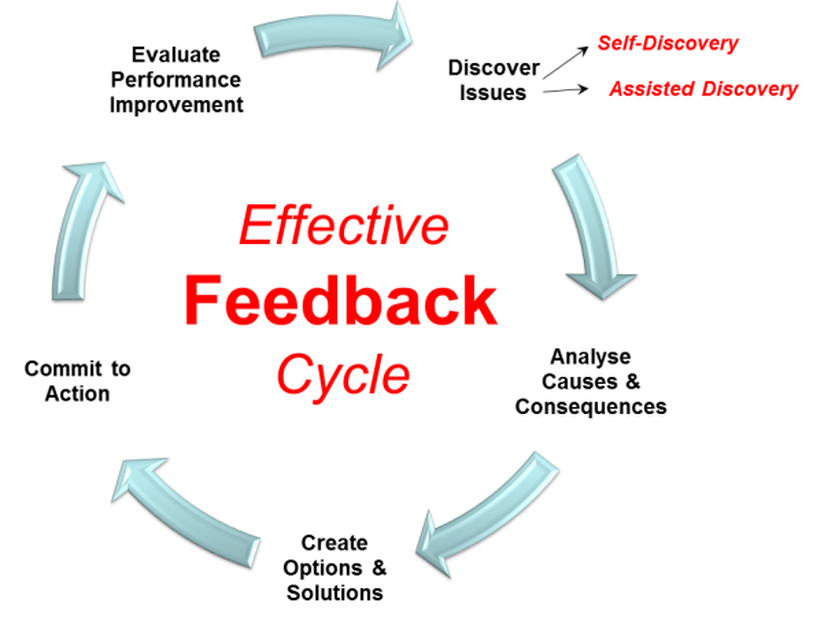Use This 5-Step Feedback “Cycle” to Improve Your Business and Relationships

I’ve been broke. I’ve been a drunk. I’ve been a jerk.
I’ve had social anxiety so bad that I would go to seminars and request a hotel room on the lowest floor possible so that I didn’t have to take the elevator with strangers.
That all changed thanks to a simple feedback cycle that has made me “normal,” richer than I ever thought possible, and the owner of my dream business, Early To Rise.
Today, I don’t drink alcohol.
People who knew me 10 years ago can’t believe how much I’ve changed.
But enough about me.
Here’s the good news for you:
There’s one tool I used to change my life, and it can change yours, too. It’s called the Effective Feedback Cycle:

But before you dive in with both feet, you first must accept that you aren’t perfect. You have to put your ego aside.
As high performers, we have an unfailing drive within us to move forward, to improve, to grow. While that’s a very positive quality, it can also lead us to shove problems under the rug—just so we can keep our momentum going.
That’s why we all need to regularly take a deep breath and examine our Effective Feedback Cycle.
I didn’t create this cycle, but it’s a simple, highly visual way to move from the recognition of a problem through feedback and resolution.
Let’s walk through each step in the cycle, using myself as an example. You can use these same steps to help you identify and solve your own problems—both personal and professional.
1. Discover the problem/issue
Without this initial step, the rest of the cycle doesn’t work. In fact, there’s no point in having a feedback cycle if you’re unwilling to see your own shortcomings.
I recommend two ways to dive into this. The first is via self-discovery. This often takes the form of meditation, focusing on negative emotions and/or the problem itself. If you focus on the problem—instead of running away from it—you will likely be able to clearly define what it is.
If, however, you’re completely lost, meditation can also guide you to the root of negative emotion. By removing external distractions and spending 5-10 minutes in a quiet space lingering with your negativity, you will uncover a lot of the triggers and root causes. The key is to “face and follow”—face the emotion and follow the triggers that make it worse or better. Several of these short meditation sessions will reveal much about what your problem actually is.
Self-discovery, however, is not the only path to defining a problem. An outside perspective is always helpful—which is why I always advocate that high performers hire a coach sooner rather than later. An attentive coach will be able to see shifts in your mood and behavior, and even recognize your problems before you do. Their perspective and experience is invaluable, so be sure you hire someone who is willing to be upfront and honest about what they see.
I’ve long practiced meditation, but I fully admit it’s only part of what I need for clarity.
Years ago, I hired a coach to “show me the mirror”—reflecting my faults, insecurities, and weaknesses back to me so I could finally see them clearly. It wasn’t fun, but it was absolutely necessary for me to figure out a path forward.
2. Analyze causes and consequences
Now that you have the problem defined, let’s map out your journey. Let’s assume that your present “problem state” is point B. You want to get to point C, where the problem is resolved. But you also know that to get to point B, you needed to start at point A.
So “face and follow” the path back to point A. What caused the problem you’re currently dealing with?
For me, my lack of vision, goals, and purpose really derailed me. I messed around with alcohol to hide the fact that I wasn’t going anywhere. But alcohol wasn’t the problem—nor was partying or staying up too late or eating junk. Those were all symptoms of a bigger problem: That I hadn’t put any effort into figuring out what I wanted in life and how to get there. And instead of putting effort into defining these critically important things, I just distracted myself with empty activities and indulgences. These just built on my existing anxiety and made my going-nowhere problem worse.
3. Create options and solutions
Every problem should have two solutions. But before we start mapping out those fixes, we need to educate ourselves.
Why is it that we landed in our current situation? Who else has faced our problem? What insight or wisdom can they offer? Are there articles online we can read about it?
More than likely, the problem you’re facing has been faced by others before you. And in the digital age, it’s likely that one of them (at least) has documented their own journey of problem-discovery through solution and resolution. Look for these materials. Reach out to others who have found solutions to similar problems. With this research as a foundation, you can devise your own two solutions.
Now you’re probably asking: Why two?
Because not all well-researched solutions will work. Don’t give yourself the chance to give up on self-improvement just because of a single hiccup. With two solutions, you can move straight from solution A (if it doesn’t work) to solution B.
When I finally started paying attention to my own shortcomings and mistakes, I knew I needed a lot of help mapping out a way forward. So I challenged myself—with the help of a coach—to network with people who had done what I wanted to do (start my own business). I learned from their mistakes and successes so that I could take steps I knew would work.
It was around this time that I also started researching success routines and techniques. I discovered the Stoics, and really began to internalize their teachings—especially their lessons on mindfulness, taking full advantage of the hours in a day, and the necessity of working outside your comfort zone.
This two-pronged approach allowed me to grow in two different ways at the same time—with one approach complementing the other. There were certain very practical things that my high-performing contacts taught me that the Stoics couldn’t and vice-versa. Both together, however, were key to my ultimate success.
4. Commit to action
As I have preached many times, “Action beats anxiety.” Once you have a solution in place and a plan to implement that solution, then act with resolve. Find accountability partners—actually business partners, perhaps, or colleagues/friends—who can check to make sure you’re following through on your “solution roadmap.”
A big part of this is routine. If you create a routine (or tweak an existing routine to accommodate your solution), you will start to build habits around daily action steps. If you know you have a strong routine in place, then weave this new solution into it.
My routine has been set for years, and has built high-performance habits that are now second-nature. I exercise daily, meditate or reflect daily, practice daily gratitude, and constantly revisit the steps I need to take to achieve my biggest goals. I share many of these tips on Instagram daily. This roadmap to success is central to my Perfect Life Formula, which I’m now able to share with thousands of high-achievers all over the world.
5. Evaluate performance
As you follow your “solution roadmap,” make sure to take pitstops to review your performance. Is your solution working? Does it really address your problem, or is it just another thing you’re doing every day? If you want, you can even create a rating scale to track progress and effectiveness.
This is where a coach really becomes valuable. Not only are they someone who provides accountability—someone you desperately do not want to disappoint—but they regularly ask you questions about how your routines, habits, and techniques are moving you toward your biggest goals.
My accountability is both public and private—I’m regularly sharing my progress with my workshops participants, my fellow coaches, and readers like you. This keeps me in a state of constant evaluation. I ask myself daily if what I’m teaching and preaching is actually working; if it isn’t, I scrap it and find a better approach.
#
See how easy that is? Five steps and I went from drunk jerk to successful friend, mentor, and coach. If I can turn my life around that dramatically, so can you.
Just remember: Whatever your high-performance goals may be, you’re likely to face problems. Don’t sweep them under the rug or ignore them. Use the Feedback Cycle to turn those problems into massive success stories—then pay that success forward by sharing your experience with other entrepreneurs.
Build your own Morning Routine that serves your BIGGEST goals and dreams…
Sign up now to get our FREE Morning Routine guide—the #1 way to increase productivity, energy, and focus for profitable days. Used by thousands of fitness, business, and finance industry leaders to leapfrog the competition while making time for the people who really matter. Learn more here.
